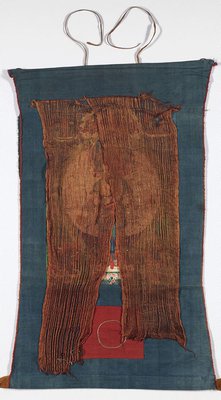-
Details
- Other Title
- Eleven-headed, 1,000-armed Avalokiteshvara
- Place where the work was made
-
Tibet
- Date
- circa 1800
- Media category
- Painting
- Materials used
- thangka; painting on cloth
- Dimensions
- 53.2 x 38.6 cm image; 98.9 x 62.0 cm overall
- Signature & date
Not signed. Not dated.
- Credit
- Gift of Dr John Yu and Dr George Soutter 2006
- Location
- Not on display
- Accession number
- 263.2006
- Copyright
- Share
-
-
About
Avalokiteshvara is the 'bodhisattva' of compassion, remaining in the material world to assist others to escape the suffering of the world by becoming enlightened. The multiple heads reflect different aspects of Avalokiteshvara – three calm, three angry, and at the top that of Amitabha Buddha, with whom Avalokiteshvara is associated. The heads symbolise his ability to counter evil powers with kindness. The first ten heads represent the ten directions (the four cardinal and four inter-cardinal directions, the centre, above, and below). The 1,000 arms surround the figure in a halo, and usually each hand has an eye in the centre. In this form, the 'bodhisattva' sees in all directions and can therefore relieve all beings’ suffering. Protective deities and lamas (a monk of great learning) from the Gelug (Yellow Hat) sect surround him.
Asian Art Department, AGNSW, 2011.
-
Places
Where the work was made
Tibet
-
Exhibition history
Shown in 1 exhibition
Conversations through the Asian collections, Art Gallery of New South Wales, Sydney, 25 Oct 2014–13 Mar 2016

